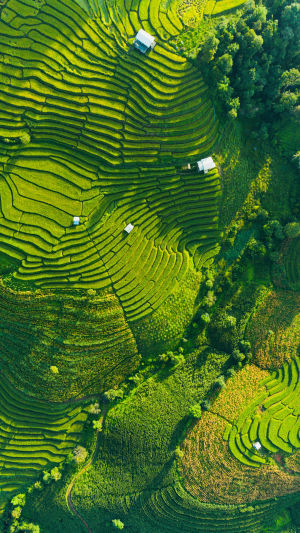Terraced fields are breathtaking, particularly when sunlight dances across rows of crops and reflects off flooded paddies. But beyond their beauty, terraced fields play a critical role in sustainable agriculture, water conservation, and even climate adaptation.
These fields are marvels of both natural and human engineering, showcasing how agricultural practices can coexist harmoniously with nature. Let’s dive into why terraced fields are not just visual spectacles but essential agricultural systems for regions with steep terrains.
<h3>1. Soil’s Best Friend: The Anti-Erosion Factor</h3>
One of the biggest benefits of terraced farming is its incredible ability to prevent soil erosion. In hilly and mountainous regions, terraced fields slow water runoff, reducing the washing away of soil. By holding soil in place, these fields prevent landslides and keep valuable nutrients where they belong: around the roots of crops. Terracing minimizes nutrient loss and makes farming on slopes not only possible but efficient, helping regions sustain crops in areas that would otherwise be at risk of environmental degradation.
<h3>2. Water Conservation Champions</h3>
Terraced fields are outstanding at water management, especially in arid and semi-arid regions where every drop counts. By creating flat, layered platforms, they allow water to settle, soaking into the soil and reducing runoff. This setup means farmers need less water for irrigation, making terraced farming an ideal solution for regions facing water scarcity. In places like the Philippines and the Andes, where rice paddies on terraces are iconic, this system supports entire communities by securing water resources in hilly landscapes.
Spectacular rice terrace fields of Vietnam
Video by The Hindu
<h3>3. Biodiversity Boosters</h3>
Each terrace can create a unique microclimate that supports diverse flora and fauna, enhancing biodiversity in the area. Terraced fields vary in temperature, moisture, and sunlight, allowing different plants and animals to thrive in each layer. For instance, some terraces can grow crops that need a little more shade or moisture, while others can cultivate drought-resistant plants. This blend of microenvironments means that pests are less likely to devastate entire fields, providing a natural form of pest control while promoting ecological balance.
<h3>4. Food Security: Feeding Communities on the Edge</h3>
For centuries, terraced fields have been vital for food production in areas with limited arable land. In mountainous regions where flat land is scarce, these fields allow communities to grow food directly on slopes, supporting self-sufficiency. Terracing maximizes the amount of land available for cultivation, enabling populations to grow crops locally and avoid over-reliance on external sources. In countries such as Peru, Nepal, and China, terraced farming is a tradition passed down generations and continues to feed communities living at high altitudes.
<h3>5. Carbon Capture and Climate Resilience</h3>
In our warming world, terraced fields contribute to climate resilience by capturing carbon and improving soil health. Well-maintained terraces reduce the likelihood of carbon release through erosion and soil degradation. Furthermore, by creating stable agricultural zones, terraced fields reduce the need for deforestation and slash-and-burn techniques that often lead to carbon emissions. This centuries-old practice also offers a buffer against extreme weather patterns, as terraces help absorb and slow down heavy rainfall, which can otherwise be destructive.
Terraced fields are a model of sustainable farming, biodiversity, and resource conservation. If you’re planning to visit these natural wonders, consider supporting local initiatives to preserve them. Whether it’s a trek through rice paddies in Southeast Asia or the highlands of Peru, take a moment to appreciate the agricultural ingenuity behind each terrace. And remember, preserving these landscapes is a step toward a more sustainable future for us all!





